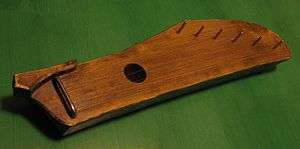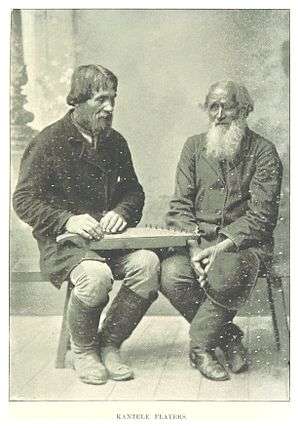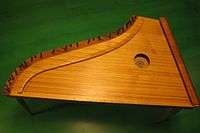Kannel (instrument)

The kannel ([ˈkɑnːel]) is an Estonian plucked zither, one of the family of Baltic psalteries which includes the Finnish kantele, Russian gusli, the Latvian kokle and the Lithuanian kanklės. The Estonian kannel has a variety of traditional tunings. In Estonia, studying the kannel has made a resurgence after some years of decline.[1]
History


The kannel became rare in the early 20th century, though surviving in some parts of the Estonian diaspora, until cultural movements under the Soviets encouraged the development and playing of larger chromatic kannels. However, influence from neighboring traditional Finnish kantele players supported the playing of the traditional smaller kannels.[2]
Social role
The kannel serves as a national symbol of Estonia; Jakob Hurt's 1875-1876 publication of Estonian folksongs was even entitled Vana Kannel ("The Old Kannel").[3] The kannel was legendarily played by the Estonian god of song Vanemuine, and the Estonian national epic Kalevipoeg (published in the 1850s) begins with the line: Laena mulle kannelt, Vanemuine! ("Vanemuine, lend me your kannel!").[4]
Players
- Igor Tõnurist
- Tuule Kann
- Mari Kalkun
- Sander Karu (Kandlemees Sander), Estonian zither player
- Kristi Mühling
See also
- Hiiu kannel, the Estonian bowed lyre
External links
- Rait Pihlap, Estonian kannel maker
- Mikhel Soon, Estonian kannel maker
- Raivo Sildoja, Estonian kannel maker
References
- ↑ Postimees: Pärimusmuusika ait lööb uksed valla (in Estonian)
- ↑ Simon Broughton; Mark Ellingham; Richard Trillo (1999). World Music: Africa, Europe and the Middle East. Rough Guides. pp. 18–. ISBN 978-1-85828-635-8. Retrieved 13 June 2012.
- ↑ David John Puderbaugh (2006). "My Fatherland is My Love": National Identity and Creativity and the Pivotal 1947 Soviet Estonian National Song Festival. ProQuest. pp. 50–. ISBN 978-0-542-83396-0. Retrieved 13 June 2012.
- ↑ Ethnologia Europaea. 1991. p. 139. Retrieved 13 June 2012.